Best drone for photography & video: Aspiring aerial photographers and videographers will surely get their start with a drone if they are serious about getting into the skies. It’s hard to argue with the results we got after testing different types of drones. DJI Mavic Air 2 was our chosen drone since it had a high-performance camera that used the latest technology, allowing it to operate autonomously. The DJI Mavic 3 and the DJI Mini 2 are two other drones that we would recommend. It is possible to fly the DJI drones, which are very easy to use even for people with minimal experience, and they are extremely reliable.
One aspect of the Pentagon report that bears mentioning is the implication that some DJI drones are safe for use, although continuing concerns exist about their security and allegations that the company has provided drone technology to Chinese detention camps. The DJI Fly application needs to be downloaded directly from the company’s website if you have an Android device.
Pick of the day: Drones for aerial video and photos
DJI’s Mavic Air 2 Drone
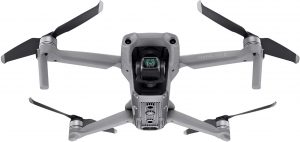

As it offers a great deal more than just 4K video capabilities, we recommend the Fly More Combo, which has three rechargeable batteries). DJI claims it’s safe to fly in winds up to 23.6 mph with the Mavic Air 2. It has the capability to sense and avoid obstacles from the front, back and below, and to maintain its position even in moderate winds. You can focus on your cinematography instead of worrying about your drone. A DJI smart-flight mode called ActiveTrack is included in this model, which allows the drone to film and follow a subject without human assistance while avoiding obstacles. With a battery that lasts 34 minutes, this drone doesn’t require landing every time a new battery is needed. Despite measuring 7×3.8×3.3 inches folded and weighing 1.3 lbs, it fits beautifully into our top drone backpack.
Upgraded pick: Everything you need in a Drone
DJI Mavic 3 Drone
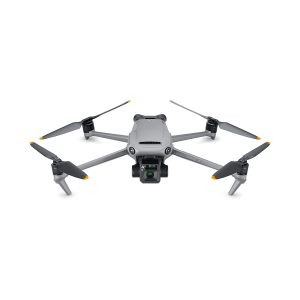

Despite sharing many features with the Mavic Air 2, the DJI Mavic 3 adds a superior 4/3 image sensor and a Hasselblad camera (DJI purchased a majority stake in the company in 2017). The photos and videos were taken by this model capture 20-megapixels and are more colorful than those taken by competitors. Additionally, the battery life is 46 minutes longer than any other drone we have tested.
Excellent as well: An alternative to DJI
Autel Robotics EVO II Drone
Autel Robotics EVO II can fly for up to 40 minutes and has autonomous options similar to those of DJI drones, if you’re avoiding DJI due to security or human rights concerns, or simply like the idea of longer battery life. Its controller is also preferred by us. Autel Explorer, unlike DJI Fly, is also available on Google Play. Our preference remains for DJI drones because of their value and superior image quality. Autel is also headquartered in China, just like DJI.
Pick for the budget: An affordable drone with impressive performance
DJI Mini 2 Foldable Drone
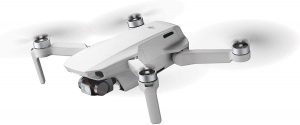

DJI Mini 2 is the best to buy and less expensive model that still includes a 4K camera if you’re just getting into drone photography for personal use and social sharing. Despite its lower camera quality and sensor, the Mini 2 has a battery life of 31 minutes, making it close to more expensive models (though the quality of the pictures and videos can’t quite match those of more expensive models). Despite its small size, this model weighs only 249 grams, which is a bit over half a pound and light enough that the user does not need to register for personal use. With the Mini 2, you get many of the important video drones features you’d expect, such as image and flight stabilization, a controller, and smart-flight modes (in which the drone flies itself automatically to capture cinematic footage).
Our reasons for your trust
Since I’ve worked closely with the industry’s professionals and hobbyists as a lifelong photographer, I’ve chronicled the rise of the hobby drone market. The smaller, more agile quadcopters designed for racing and those focusing on photography have fascinated me for many years. The IBC24 guide to drones under $100 is based on my experience flying drones in numerous environments. Additionally, I hold a certificate in remote piloting.
Best Drone Under Budget to Buy:
DJI Tello Drone
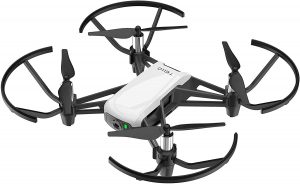

For anyone who wants to discover aviation, the DJI Tello is our favorite cheap drone for aspiring pilots, racers, and kids.
For whom this is intended
You can outfit quadcopters with cameras to take bird’s-eye view photos and videos using drones (or, more specifically, quadcopters). Photographers and videographers may be interested in them if they wish to reach areas where cranes or helicopters would normally be needed, such as high up in the air or across a body of water.
No matter which drone you choose, be aware that drone flight and usage regulations are constantly evolving and you need to familiarize yourself with them before buying. Modern photography drones have autonomous capabilities that make them easy to master, but they may take weeks to master. This guide covers the best modern photography drones available today. We’re not talking about preparing for a sunny afternoon on the soccer field. We’re talking about preparing for the moment when high winds pick up your drone and blow it across the neighborhood (yes, we’ve experienced this). Listed below are a few tips to help you fly safely and stay in compliance with federal and local regulations.
There are also some thoughts on privacy and security that we’d like to share with you, including best practices that can help you prevent drone companies from sharing your information. This guide only recommends drones made by Chinese manufacturers. There is an ongoing concern within the government about the use of Chinese technology to monitor US citizens. Depending on the sensitivity of your footage, you’ll have to make that call at the hobby and professional levels. Human rights violations are another issue. If you’d prefer to avoid Chinese drones entirely (but not Chinese parts), you can opt for drones from Parrot (whose security practices it has documented) or Skydio (based in the US).
In this guide, we discuss drones that might interest professionals such as those who are planning to film weddings, inspect gutters, or use them to videotape properties before they are put up for sale. But professionals shooting a film might want to explore higher-end options with specific mounting options for camera equipment. Additionally, there are options for people who want to inspect farmland or industrial equipment, since specialized sensors may be needed.
Modern drones under budget can be purchased, thanks to improvements in technology and dropping prices. Our guide to cheap drone models (without nice cameras) that are perfect for learning how to fly is great for anyone looking for their first drone.
Our process of picking and testing
We decided to consider the following criteria when looking for drones to test after reading reviews written by professionals and owners, as well as talking to experts, enthusiasts, and manufacturers at the CES trade show:
Four-rotor drones: X-shaped quadcopters are more maneuverable than plane-shaped drones, which look like airplanes. Hequadcopter’s shape (or an alternative such as a hexacopter adding more arms) makes for the most stable photo and video because they can steadily hold their position in the air.
Drone crash prevention sensors: A drone’s flight path can be adjusted based on obstacles approaching from any direction, with some models being able to detect obstacles in any direction and avoid a crash. We are willing to consider only drones that, at the very least, can sense obstacles approaching from above, below, and in front of them as this technology alleviates so much stress when flying.
An excellent camera: In general, the higher the price of a drone, the better the camera. Only models with a minimum 12-megapixel camera and 4K video were considered.
Gimbals with three axes: If you want usable footage from your drone, you will need a good three-axis gimbal that can stabilize a camera with accelerometers and gyroscopes even when you are flying in light winds. General industry standards call for a three-axis gimbal.
Battery life: Long-lasting batteries tend to be larger and heavier, so drone manufacturers make sure to balance the size and weight of their drones. Shorter flight times, however, mean fewer shots, shorter videos, and fewer shooting options. We recommend drone batteries that last for at least 20 minutes, and we highly encourage pilots to buy more batteries (the batteries are rechargeable) so they can spend more time flying in the field.
An autonomous mode: In order to make buying a video drone worthwhile, the drone should come with a fail-safe return-home mode that automatically returns the aircraft to the launch point when the drone loses contact with the controller or when you press a button. Furthermore, we prefer the best drones with cameras that have cinematic automatic-flight modes; with the touch of a button, you can instruct a drone to follow you while you snowboard down a mountain or to record a dramatic selfie while flying in a circle.
Portable: The best drones to buy should be portable enough to be used as an everyday tool, which implies that they should be small, light, and easy to carry. The arms of some drones can be folded so they are more compact.
The range of a drone is long: Drones cannot be flown beyond the line of sight of the pilot. Drones’ ability to fly a long distance without losing contact with a controller can be particularly helpful in certain situations.
Controllers look similar: Controllers for drones typically consist of two joysticks for control and a handful of buttons for various functions. The functionality of controllers with integrated screens or the ability to attach a smartphone (so you can gain additional capabilities via an app) can be extended even further, often more intuitively.
In addition to evaluating camera quality, we also measured stabilization and checked whether propellers could be seen in any of the shots taken with each drone. Our drones were also flown through trees to test all of the advertised intelligent-flight modes and crash-avoidance systems. As we flew fast and turned a lot, we tested the maneuverability and sensitivity of the controller.
To determine which extra gear is truly worthwhile for photography drones, we spent dozens of hours reviewing and testing drone accessories, such as backpacks, first-person-view headsets, and landing pads.
Highly recommended: DJI Mavic Air 2 Drone
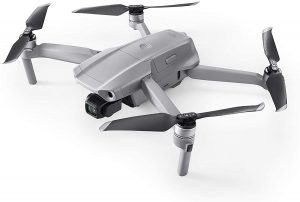

Due to its automated obstacle avoidance and 4K camera, as well as how easy it is to fly, the best drone to buy is DJI Mavic Air 2 for budding aerial photographers and videographers. Moreover, the three-axis gimbal provides effective image stabilization, while the battery life is 34 minutes, so landings are far less frequent. Beginners and advanced pilots alike can get cinematic-looking photos and video with the Mavic Air 2’s preprogrammed flight modes and ability to return to the launch spot and land automatically. Even though the Mavic 3 boasts an improved camera, battery, and autopilot abilities, we think the Mavic Air 2 is more than adequate for most people – and it costs a third less.
Obstacles can be sensed as far as 155 feet away by the Mavic Air 2, whether they’re approaching from the front, back, or bottom, and then be avoided by the drone. However, even though the Mavic 3 added sensors for up and to the side, we still found the feature useful for normal flying; when I tried to fly straight at a tree or slam it into the ground, the drone emitted a loud beep and stopped itself. When you are flying manually or when using one of DJI’s pre-programmed options, obstruction sensing eliminates stress from the flying experience.
It is equipped with a 12.1-inch sensor with 12- and 48-megapixel modes, as well as a 4K video camera that can shoot 60 frames per second. Our tests showed that the Mavic Air 2 shot sharp videos without fussing over its color balance (despite the fact that we still preferred the colors from the Mavic 3’s Hasselblad lens). It is possible that a new feature called SmartPhoto (which recognizes what the camera sees and adjusts colors appropriately) played a role in this, though it is hard to say what exactly it changed.
A Mavic Air 2 remained stable even when flying in winds of about 10 mph. In spite of the fact that it soared hundreds of feet over the Mississippi, the drone kept shooting steady video. Mavic Pro and Mavic Mini performed similarly (with the exception of the Mavic Mini, which advised us to land due to high winds). Mavic Air 2 monitors movement and altitude changes by using GPS and GLONASS satellites, as well as vision cameras.
Flying a drone can be frustrating, but it can also be frustrating to get into the rhythm of flying and then be alerted that the battery needs to be changed a few minutes later. Our guide to inexpensive drones covers drones with this problem and answers like how much does a drone cost. You shouldn’t have to worry about battery life anymore. Our first Mavic Air 2 battery lasted 34 minutes, allowing us to record video footage for 8GB before it ran out of power.
In addition to the preprogrammed flight modes, photographers and cinematographers can enhance their skills. The drone was most often tracked with ActiveTrack, which directed the drone to follow a subject (or yourself). When the Mavic Air 2 is put into QuickShots mode, it can film autonomously in cinematic ways such as zooming in on a subject or circling around it. Also helpful is tripod mode, which limits the drone’s speed to 3 mph (to prevent the drone from jerking during shots), and softens the controls (for smooth shots).
When folded, the Mavic Air 2 is about the size of a coffee thermos and weighs 1.3 pounds. A sandwich can be the size of its controller when folded. Both can be slipped into a camera bag or stowed in a purse or backpack easily.
Though a drone must remain within your line of sight, the Mavic Air 2 can fly up to 6.2 miles away. We have found DJI’s OccuSync 2.0 system to be reliable for transmitting video and remote control data.
With DJI’s mobile app, you can calibrate your drone, access camera settings, view GPS maps, and control smart-flight modes. You can also frame shots according to your liking with the app’s live feed from the drone’s camera. A variety of additional features include tracking all of your flight information (which you can replay when you’re trying to repeat a shot), warning you about any area flight restrictions, and having built-in video-editing tools. A USB Type-C, Micro-USB, or Lightning cable is included for connecting your smartphone to the controller. A standard cable can be used in place of the included cable, but it sticks out oddly and limits your movement.
It is still necessary to use the DJI controller to pilot the drone, even though the DJI app can operate nearly all aspects of it. Even in the faster and more agile Sport mode, the drone responded nimbly to our controllers. It was also simple to tilt the camera of the drone using the controller’s wheel or to control the camera’s actions using the specialized buttons.
Flaws but not a deal-breaker
In recent years, DJI has been scrutinized by the US government and security researchers due to security concerns. The DJI Fly app for Android will also need to be downloaded from DJI’s website instead of the Google Play store. Below is some information regarding DJI drone security.
We prefer the Mavic 3’s addition of top and side sensors over the Mavic Air 2’s front, back, and bottom sensors when it comes to preventing collisions. Taking off from a tree was more difficult with the Mavic Air 2 since it was hard to determine how close branches were from a distance. A second sensor reduces flight stress.
A smaller camera sensor is also found on the Mavic Air 2 as compared to the Mavic 3. Video taken by the Mavic 3 looked even sharper and had better colors than the videos taken by the DJI S1000.
There is no built-in screen on the controller. This isn’t a big deal if you have the drone connected to your phone and launch the DJI Fly app (which gives you the same information a controller screen would). Nevertheless, it was a minor inconvenience that we didn’t have when we wanted a quick flight without a phone. You can also explore the pocket drone under the best budget.
Pick for upgrade: DJI Mavic Pro Drone
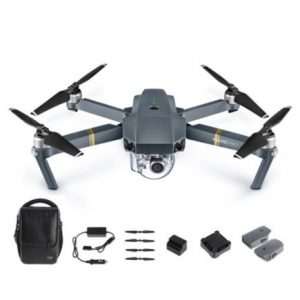

Despite the higher price tag, the DJI Mavic Pro offers an improved camera and improved obstacle avoidance. Video and photos from this 4/3 sensor are clearer and more colorful than those shot by a Hasselblad camera. Additionally, the Mavic Pro can sense obstacles coming from a wide variety of directions and compensate accordingly, making flying somewhat safer.
With its sensors, the Mavic Pro can identify obstacles approaching from the sides (in certain flight modes), the front, the back, the bottom, and the top of the aircraft. Using these sensors, it is able to adjust its flight path to avoid collisions and avoid damage. DJI’s sensing and obstacle-avoidance system APAS, which is present in the Mavic Air 2, does not include obstacle detection on its sides or top. While testing it, we were unable to fly the Mavic Pro to a tree. When we instructed it to return to its launch point autonomously, it flew around a tree that was blocking its path. Whenever we flew close to an obstacle, including fine tree branches, the drone beeped to warn us, and it slowed down during landing to gently touch the ground every time. It should be noted that the Mavic Pro’s side sensors are only active while flying in Tripod, POI, QuickShot, and ActiveTrack modes. You can turn off obstacle avoidance and detection if you ever need to fly close to an obstacle for a perfect shot or a more sports-like performance.
A camera of this size is not able to capture the same quality as Hasselblad’s larger cameras because it is so small. The two companies did, however, collaborate on a few features that are notable on a drone, including a 4/3 CMOS camera that works in low-light conditions (the Mavic Air 2 has a 12-inch sensor). Adapting Hasselblad’s method for making colors more realistic without having to play with color settings is another achievement of the companies. Indeed, we found the colors to be more vibrant and accurate than those of the Mini and Mavic Air 2 & 3 . In addition to 5.1K video, the Mavic pro records digital media at a maximum bit rate of 200 Mbps (the camera’s processing speed). Mavic Air 3 has a fixed aperture of f/2.8; the aperture can be adjusted anywhere between f/2.8 and f/11.
The Hasselblad lens is attached to a second camera. The 12-inch digital camera can capture images and videos of 12 megapixels and 4K resolution. It is designed specifically for telephoto photography. Although DJI advertises it as a 28x hybrid zoom, it has a 4x digital zoom.
Mavic pro’s consistent stability is comparable to the Mavic Air’s. We tested its hovering accuracy, and it showed no signs of drifting. We felt we were able to consistently have the right shot without having to worry about crashing when APAS 5.0 was paired with it.
Despite folding down to 8.7 by 3.8 by 3.6 inches, the Mavic pro is just as portable as the Mavic Air 3. Besides removing the camera cover, there’s no assembly required before you fly. Your controller takes up enough space to fit in your hand. In spite of its heavier weight, the Mavic pro is still more convenient than the Mavic Air 2. The camera can be stowed in a conventional camera bag or even a purse.
In order to support Apple ProRes 422 HQ, DJI offers an upgraded Mavic pro Cine model that comes with a 1 TB SSD and RC Pro controller with a built-in screen.
Great as well: Autel Robotics EVO II
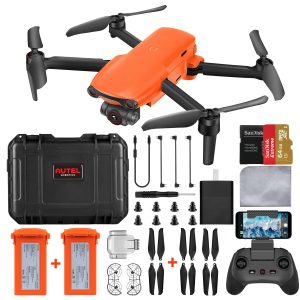

Autel Robotics EVO II is a worthy competitor if you would like an 8K camera and longer battery life without having to buy a DJI drone. Since our first Autel drone was tested a few years ago, we found that they were just as easy to fly as their DJI counterparts. There are also many autonomous flight modes available in the well-designed app from the company. The images and videos we see from DJI drones are still crisper and more colorful than those produced by these other drones.
A slight upgrade on specs compared to the Mavic Air 3, but a stale experience when compared to a drone from the next generation. The EVO II is more comparable to an older DJI model like the Mavic 2 Zoom, over which it has a slight advantage. With a 48-megapixel, 8K camera and 12.8-inch sensor, the EVO II feature a 4x lossless zoom (with an option to zoom in as much as 8x). On the other hand, we found that DJI drones were better at capturing colors.
Another big selling points are the EVO II’s 40-minute battery life, which is nine minutes longer than the Mavic Air 2 but five minutes short of the Mavic 3. There aren’t many times when we find ourselves wanting a longer battery life than 30 minutes, but pilots who want a greater transmission range of 5.6 miles might find this useful.
It detects obstacles from most directions and can avoid them autonomously, just as the Mavic 3 can. The robot stopped after detecting a chain-link fence and a white snowman, and both times it avoided a collision.
Controllers for drones usually come with clamps that can hold your phone, where a Livestream from the drones’ cameras is displayed. It’s best to use controllers that hold your phone above the controller, not below it, like the EVO II’s. Keep your head up so you don’t have to tilt your head down so far to check your phone when you’re trying to keep an eye on a drone. This is the best phone drone. Additionally, we like the EVO II’s bright orange color better than DJI’s matte gray, which makes it easy to spot in flight. While Autel drones are much louder than DJI drones, we find that DJI drones are quieter.
Drones worth checking out:
Drones with first-person views use a headset that projects a live video feed from the drone’s camera to your eyes, giving you the feeling of flying. As part of the DJI FPV drone, we had the most enjoyable experience we’ve ever had flying a drone. Since you can see the tree ahead, you’re not trying to guess from several hundred feet away that you’re about to hit one. It’s an intuitive way to fly. DJI’s solution requires little technical skill and includes a 4K camera and obstacle detection, which is a great addition to FPV headsets. Although it doesn’t use as large a sensor or have autonomous flight modes as our top picks, it provides a thorough experience for those who are focused on cinematography. We didn’t attempt it, but you’ll be able to fly as fast as 87 mph (no, we didn’t try that). When you pull on the FPV headset, you must have someone always within sight of the drone, because the law requires you to have a spotter.
The Autel EVO II Pro was also tested and enjoyed. With the better camera, it’s more competitive with Mavic drones (though it won’t provide the same value as an EVO II 8K). Purchasing an EVO II Pro camera and swapping it with the one included with an EVO II allows you to upgrade to the EVO II Pro camera later.
The best DJI drone accessories
Flying a drone alone can be a lot of fun, but a few key accessories can make your flights even smoother and more enjoyable. In order to find the best backpacks, first-person-view headsets, landing pads, and microSD cards for foldable DJI drones, we tested more than forty drone accessories and interviewed four expert drone pilots. Adding additional batteries will allow you to extend your flying time between charges.
A backpack designed for drones:
Pick of the day:
Lowepro DroneGuard BP 250
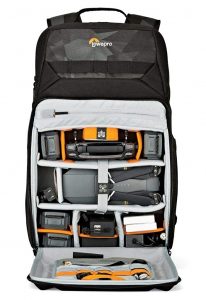

Each piece of a kit is kept snugly in place in a drone backpack, making it easier to find items without digging through a lot of gear and protecting your equipment from damage. Leaving batteries to bang around can cause them to burst into flames if you don’t care for them. Twenty-two options were considered and four finalists were tested by fitting three DJI drones of varying sizes with all the necessary accessories, including batteries, chargers, props, cameras, and a laptop.
In our opinion, Lowepro’s drone bags are best because of their fit and organization as well as the fact they are still quite comfortable to carry when you are fully loaded. In our testing, we used the Lowepro DroneGuard BP 250, a backpack specifically designed for DJI Mavic drones. However, any backpack from the DroneGuard or QuadGuard series would function similarly.
You can access the main compartment of the BP 250 by zipping the entire front. Separators make it possible to store smaller items, such as the drone and its controller, and make sure the batteries are snugly tucked away. The drone is secured in place by a strap, and a special foam block is tucked between the joysticks of the drone controller. There are elastic bands on the front cover, which are perfect for holding extra propellers or securing cords (to keep them from tangling). In our tests, we were able to fit an FPV headset or a disassembled camera body and lens into the main compartment of the drone.
Other spaces are designed for a camera and tablet, flat items like prop guards, and large items like FPV headsets or cameras. The front straps come with pockets for the phone and tablet. The backpack comes with looped straps on the front that you can attach gear to using bungee cords, as well as two side pockets for water bottles or sunscreen.
In spite of the clear multiple compartments of the BP 250, its dividers are only so flexible, so a DSLR cannot be easily inserted into the main compartment. If you plan to use the backpack only with one drone, this bag, and the other DroneGuard and QuadGuard backpacks are great choices. We recommend the Peak Design Everyday Backpack 30L if you prefer to customize your backpack.
Best drone landing pads
Pick of the day:
Hoodman Drone LaunchPad (3 feet)
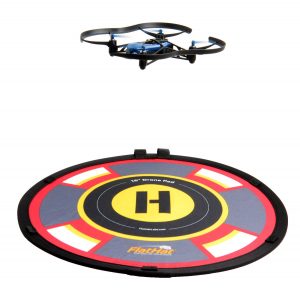

A dedicated landing pad protects your investment from water, dirt, and other elements when you fly an expensive drone equipped with a camera on its belly. When you’re wearing an FPV headset, these pads are a perfect visual indicator of your location, because they tend to be a bright orange color. You can also use them in videos (if you are providing content to a client).
We recommend the Hoodman Drone Launch Pad after testing three (and a piece of cardboard) due to its truly waterproof construction, its ease of installation, and its unique weighted edge. Landing pads should be waterproof, but the other two we tested (from RCstyle and Fstop Labs) proved to be unwaterproof, despite their makers’ claims. The water was still beaded up after 20 minutes, and there was no sign of moisture leaking through to the other side of the Hoodman pad.
In addition, we like the metal weighted edges of this landing pad, which keeps it from flying away in high winds. The stakes add weight to your gear (compared with stakes used by other pads), but they also make the Hoodman pad easier to set up and more useful if you’re flying on hard ground (like rocky fields or parking lots). Pleasing orange color is found in the center fabric, which feels stronger than the material of the other pads we tested.
It packs down to 13 inches across and fits nicely into its carrying case, but its 3-foot length made it more difficult to fold up than smaller models. Your drone’s size will determine the size of the pad you need. A 5-foot Hoodman drone could be quite useful for professional cinematography, but its size is at odds with most drones. Also, it is more visible from the air due to its larger size.
Best Micro-SD Cards For Your Drone:
Pick of the day
SanDisk microSDXC card for Nintendo Switch (128 GB)
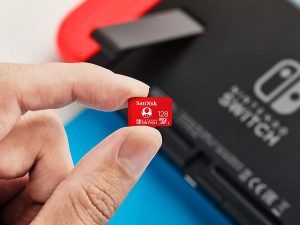

With its fast read and write speeds, the SanDisk MicroSDXC card for Nintendo Switch (128 GB) is the best microSD card to use with drone photography because it makes quick file transfers and is ideal for capturing 4K video. With more storage, you won’t have to land your drone early to replace a card, which is important for a photography drone and even a race drone with a nicer camera. It is also an inexpensive SanDisk MicroSDXC card.
By purchasing a memory card from a reputable memory storage company like SanDisk, you can be sure that the videos and photos you take will be there when you upload them. If you buy a SanDisk card, you can purchase it directly from Amazon or the manufacturer. Be aware of counterfeit microSD cards from unknown sellers on Amazon, which are common. Our guide to the best microSD cards includes more information on the competition.
Security and privacy tips for DJI drones
Security and privacy are two of the concerns about drones as a whole. Aerial surveillance is available to anyone for just a few hundred dollars and has privacy issues similar to other connected devices. You can find more information on this topic at The Electronic Privacy Information Center and National Law Review.
There are a lot of features in the DJI apps that allow you to comply with federal regulations about where you can fly a drone using a geofencing feature. DJI drones have reportedly been found to have potential security flaws. A drone company is also suspected of providing surveillance technology for Chinese detention camps. After the Federal Aviation Administration placed DJI on its entity list in 2020, US companies would no longer be able to export their technology to DJI, but the company could continue to sell their drones in the US. Some DJI drones were approved for government use by the Pentagon in a 2021 report, but there was no definitive guarantee that there would be no abuses of human rights or any safety concerns about consumer drones from the brand. FCC Commissioner Brendan Carr proposed the UK add DJI to its banned list for October 2021, meaning that federal funds could not be used to purchase DJI drones.
Apple devices can download the DJI Fly app from the App Store, but Android devices cannot download it from Google Play. DJI and Google didn’t respond to our question about why the two companies choose not to answer. The app can be downloaded from the DJI website. There is a little bit of security in the Google Play Store, but it isn’t perfect. We are uneasy about DJI Fly’s availability only through the DJI website. This will be monitored closely.
As per a company spokesperson, DJI collects anonymized app performance data with consent. It is also useful for geofencing and radio frequency transmission purposes while flying a drone, which is a legitimately helpful resource. The DJI servers on US soil store any information uploaded to DJI. No data is sold by DJI to third parties. This does not mean that DJI cannot share data with third parties; the company’s complex privacy policy suggests that DJI is allowed to do so. Furthermore, its iOS app currently lists data under Apple’s “Data Used to Track You” label, indicating that data is shared, possibly for advertising purposes. Images from the drone are encrypted and transferred to the controller. According to a company representative, the company performs vulnerability scanning and penetration testing as part of product development, as well as running a bug bounty program.
Although we have spent hours researching DJI drones, we still have privacy and security concerns. Furthermore, there can be no doubt that the best drones will be available to hobbyists through this program. As a result, we still recommend the company’s drones but will continue to monitor its practices.
There are a few steps you can take to make your photos, videos, and data as secure as possible if you decide to buy a DJI drone:
- Setting your phone or tablet to airplane mode, or activating the “local data mode” in the DJI app, is a good idea when operating a drone.
- Turn off the app’s data collection in its settings to prevent it from collecting performance and user experience data.
- Alternatively, if you’d rather not use your phone or tablet, you can fly without one (though you’ll lose the helpful Livestream) or purchase the DJI RC Pro controller, which features its own screen.
- You should save your drone’s photos and videos only to its internal memory, microSD card, or SSD.
- Do not share drone content on social media apps or sites like Facebook or SkyPixel.
While flying a drone, the DJI app offers valuable features such as geofencing and enabling your photos and videos to be accessed. Using them off means that you will not receive alerts regarding federally regulated airspace (the FAA makes the B4UFLY app, which you can check manually), you will not be able to locate your drone if you lose it, and you will not be able to review your photos or video until you place the memory card on your computer. The drone is also more difficult to position itself in visually challenging situations like snow, rain, and low light when it is relying only on its vision system instead of satellites. In balancing security and privacy with function, pilots will have to make a personal decision.
A guide to flying recreational drones safely
In any drone flight, it’s important to be sure you, the pilot, are following the rules and following all the safety precautions. While we are unable to offer legal advice, we did consult experts and FAA and Academy of Model Aeronautics documents to gather the steps that we believe every recreational pilot should take.
Tyler Dobbs, Academy of Model Aeronautics government affairs representative, said, “The key thing to remember is that we’re sharing the airspace with manned full-size aircraft.” We won’t go beyond AMA safety guidelines, nor do we want to break FAA rules. Play around, but do so within a legal and safe path set up by the federal government.”
Become familiar with the AMA
There are different laws and rules for different types of drone pilots. Specifically, we’re discussing drones used for recreational purposes, referred to by the FAA as “model aircraft.” That means drone operators can’t sell photos or videos they shoot with their drones, or use them for other business activities.
A recreational drone pilot can either obtain a remote pilot certification from the FAA, which requires an in-person test, or “follow safety guidelines laid out by a local community organization and fly within its programming” (a much easier option). Drone lawyer Jon Rupprecht, a commercial pilot, said “this is the chief thing you have to pay very close attention to,” adding that people often do not see or understand this. A widely accepted option is the Academy of Model Aeronautics, which does not require you to join a nationwide organization. Download the AMA handbook (PDF) for more information.
Obtain a registration number
As soon as you agree to follow AMA rules, you will need to register with the FAA. Checkout takes about two minutes on the FAA website. It costs $5 to register and you will need to submit your name, phone number, and address. A three-year registration number is then issued by the FAA. You can also print a certificate, which could prove useful if a police officer or another person questions you on the ground.
You need to register a drone for three years, then label each drone you fly with the registration number. A recreational pilot does not need to complete a new registration for each drone they fly, unlike commercial pilots.
Make sure you know the rules
A good starting point would be to read both the FAA guidelines and the AMA handbook (PDF). It is possible that they may conflict at times, but these are the essential rules that apply nationally:
- Make sure you maintain a clear view at all times. The spotter must be able to visually see the drone without the aid of binoculars if you are wearing a first-person-view headset.
- Weight restrictions apply to drones that weigh less than 55 pounds unless they are certified by a community-based organization.
- Beware of other aircraft if you are flying near them.
- Airplanes should not be flown within 5 miles of airports. It is your responsibility to notify the airport and the air traffic control tower before the flight. The AMA Flying Sites Map or DJI’s mobile app can help you determine if you are far enough away from an airport.
- Aircraft should not be flown near emergency responses.
- Intoxicated or drugged pilots should not fly.
At the local level, drone flights can also be governed by additional rules. It is illegal to fly a drone within 15 miles of Ronald Reagan Washington National Airport or the US National Park System (unless there is a designated area). Your city and state should have specific regulations regarding drones.
Also check: How To Choose The Best Smartphone Tripods In 2023
Things to Know Before You Fly a Drone
When flying a drone for the first time, try to minimize the possibility of anything going wrong. Educate yourself about safe setup and flight by reading the manual and watching YouTube videos. In years, we haven’t encountered a photography drone that broke from an impact (DJI offers a repair program called Care Refresh, and replacement parts for breakable parts like rotors are readily available). However, avoiding crashes is still important for safety reasons. Drones falling on people or property can cause injury.
They crash these things unnecessarily because they don’t read the manuals. The first and second flights are terrifying. On your third flight, you listen to the music from the movie Top Gun and you say, ‘I’m sure I can do it! I’m sure I can!’ Then you go outside and you crash. So before you do anything, make sure you don’t do anything unlawful.”
Investing in a flight simulator might prove worthwhile before you venture into the skies for the first time. Otherwise, you should learn from others how to fly a drone for the first time. Your local drone club may help you. I have found the members to be welcoming, and they are quick to show you the basics.
“They’ll teach you the rules, they’ll teach you how to fly, they’ll show you that, yes, there are a few things you have to consider when operating in an airspace, but overall it’s an enjoyable hobby,” Dobbs said.
Additionally, here are some helpful tips:
- Select a site where there is plenty of space, few obstructions, and few people.
- In adverse weather, do not fly.
- Have a plan to return the drone if something goes wrong.
- Don’t go beyond what you’re capable of.
Although drone flights are governed by many rules, the experience should still be about having fun. Don’t forget the reason you started flying in the first place, take your time learning new things, and don’t give up.
Looking forward to these things
Our current top pick, the Mavic Air 2, has been updated with the Mavic Air 2S. In addition to an improved camera and improved autonomous features, the Air 2S has obstacle sensing. Unfortunately, its battery life is slightly shorter. The results of our testing will be added to this guide shortly.
Competitors
Over the years, we have recommended many DJI drones. It’s likely a good deal to purchase an older model at a low price with specs that meet your needs. In recent years, drone technology has been rapidly evolving; new models offer longer battery lives, better cameras, and better autonomy.
Parrot Anafi is an excellent value for the money. On the 180-degree tilt gimbal, the 21-megapixel camera shoots 4K HDR video. It can reach a top speed of 32 mph and has a battery life of 25 minutes. Furthermore, it’s made by a French company (with a transparent security policy), so it’s a good alternative to Chinese drones made with less security. The lack of obstacle sensors in the Anafi disqualifies it as a potential pick because obstacle avoidance is so important. If you’re an experienced pilot on a budget and you’re less concerned with obstacle avoidance than a high-quality camera, it would be a better choice than the Mini 2. During our testing of the FPV version, we found the headset helpful for lining up shots. We also found the backpack to be of high quality.
During testing, we encountered a number of problems with the original Skydio drone’s ability to avoid obstacles reliably. The Skydio 2 has received positive reviews, and it might be a good choice for outdoor pictures for sports enthusiasts who primarily need an autonomous drone. DJI drones offer more options and are a better option for the majority of cinematographers due to their versatility, both manually and automatically.
Among the drones recommended in this guide, the DJI Mini 2S is the least expensive. If you want a drone that takes excellent images while also providing autonomous features which make drones safer and easier to fly, this is the most affordable option. You can also get into the air with our guide to the best drones under $100; they are packed with features to make flying a breeze. Drones in the middle price range are possible, but we do not recommend them at this time; they sacrifice both camera and safety features, and they are not very satisfying to fly.


With a specialization in tech, travel, and gadgets we bring a unique perspective and passion to each area and provide reviews and ratings of the Latest Technology Products, Gadgets, Home Essentials, Mobile phones, Health Products, Lifestyle, cameras, & apps, etc.






